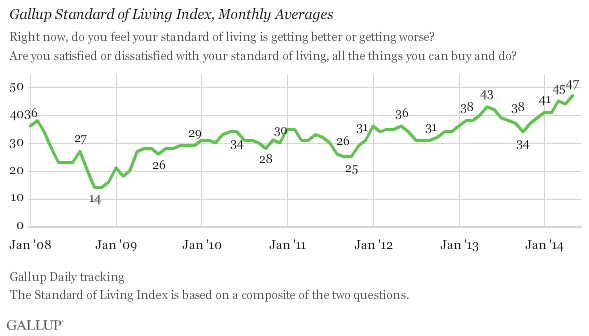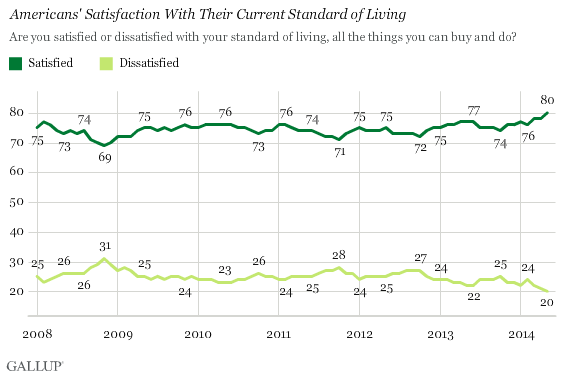
In U.S., Standard of Living Index Climbs to Six-Year High
Perceptions of current and future living standards both at record highs
WASHINGTON, D.C. -- Gallup's U.S. Standard of Living Index climbed to 47 in May, the highest score recorded since Gallup began tracking this measure in 2008. This index score is up slightly from 44 in April.

After reaching a low of 14 in October and November 2008 during the Great Recession, the Standard of Living Index fluctuated; it generally moved in an upward direction since that time. The index dipped down to 34 during the U.S. federal government shutdown in October 2013, but has generally increased since then.
Gallup's Standard of Living Index is a composite of Americans' responses to two questions: one asking whether they are satisfied with their current standard of living, and the other asking whether their standard of living is getting better or worse. The index has a theoretical maximum of 100 (if all respondents say they are satisfied with their standard of living and say it is getting better) and a theoretical minimum of -100 (if all respondents are dissatisfied with their standard of living and say it is getting worse).
Last month, 80% of Americans said they were satisfied with their standard of living, while 20% said they were dissatisfied. This results in a net current satisfaction score of 60, a new high.

Looking forward, 59% of Americans said they believed their standard of living was getting better -- also the highest on record -- and 26% said it was getting worse. The resulting net expectations score of 33 is also the highest in Gallup's more than six-year trend. Americans' optimism about their standard of living fell to a record low in October 2008, amidst the global financial crisis, when 33% said their standard of living was getting better and 47% said it was getting worse.

Bottom Line
Americans' improved views of their standard of living mirror their increased perceptions job creation, which also reached a new high in May. Furthermore, Americans' self-reported spending increased sharply last month, and their views of the economy's current and future health improved. The lingering question is whether these improvements will continue as the year progresses.
Survey Methods
Results for this Gallup poll are based on telephone interviews conducted May 1-31, 2014, on the Gallup Daily tracking survey, with a random sample of 3,103 adults, aged 18 and older, living in all 50 U.S. states and the District of Columbia.
For results based on the total sample of national adults, the margin of sampling error is ±2 percentage points at the 95% confidence level.
Interviews are conducted with respondents on landline telephones and cellular phones, with interviews conducted in Spanish for respondents who are primarily Spanish-speaking. Each sample of national adults includes a minimum quota of 50% cellphone respondents and 50% landline respondents, with additional minimum quotas by time zone within region. Landline and cellular telephone numbers are selected using random-digit-dial methods. Landline respondents are chosen at random within each household on the basis of which member had the most recent birthday.
Samples are weighted to correct for unequal selection probability, nonresponse, and double coverage of landline and cell users in the two sampling frames. They are also weighted to match the national demographics of gender, age, race, Hispanic ethnicity, education, region, population density, and phone status (cellphone only/landline only/both, and cellphone mostly). Demographic weighting targets are based on the most recent Current Population Survey figures for the aged 18 and older U.S. population. Phone status targets are based on the most recent National Health Interview Survey. Population density targets are based on the most recent U.S. census. All reported margins of sampling error include the computed design effects for weighting.
In addition to sampling error, question wording and practical difficulties in conducting surveys can introduce error or bias into the findings of public opinion polls.
For more details on Gallup's polling methodology, visit www.gallup.com.
